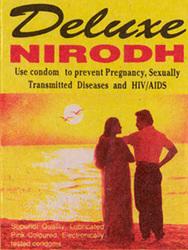 Nirodh condoms marked for free distribution are being illegally diverted from government supply lines and sold as foreign brands in the down-markets across India.
Nirodh condoms marked for free distribution are being illegally diverted from government supply lines and sold as foreign brands in the down-markets across India.
The supplies leaving the government's Hindustan Latex Limited plants, essentially to help in the fight against AIDS, are spirited away by operatives to private latex factories, where they are put in glossy, erotic covers, rebranded, and sent to vendors in Jaipur, Indore, Ranchi and other faraway places, investigations by a team of PTI correspondents have revealed.
The head of a social marketing organisation in Delhi shows how the repackaging is done. With his thumb he pushes a condom out of the sealed Nirodh strip and into a new foil open at one end. He does not touch the condom; just uses the condom lubricant to aid the transfer.
"There are well-trained hands in the factories," he explains.
"In factories where machines are used, almost one lakh pieces can be transferred in a day."
Down in the bazaars, Rakesh Rathore (name changed), an insider, bares the proof of trade. At a non-descript shop in Jaipur that he does not want identified, he picks a label called Sweet War that bears the company name, Tricon Impex, but has no address.
He rolls back the condom from it to show the HLL code, H9F, printed near the rim opening.
"It is of recent stock," Rakesh explains, drawing a nod from the shopkeeper. "The H stands for HLL, 9 for the year and F for Free supply."
"I have a few more cartons of those," the shopkeeper says. "I have made desperate men pay up to Rs 15 for a pack (of three)."
"They have become reticent these days. . . The code on the condoms has multiplied the risk of their getting caught", he says.
The coding system came into force in 2006. Until then the operatives were having a free run, knowing that no one could prove the source and provenance of the condoms once they had been repackaged.
In 2006, the police raided a Maharashtra-based factory and seized condoms meant for free distribution worth Rs 20 lakh (Rs 2 million). The raid blew the lid off the largescale scam.
"We had suspected things were amiss," says the then health secretary Naresh Dayal in whose tenure the coding was introduced. From 1998 onwards, agencies including the Central Bureau of Investigation and Central Vigilance Commission had started probing the deals in HLL.
"There were even indications that the supplies were getting diverted and sent abroad," says Dayal. ". . .but with the coding system in place, we thought we had seen the last of the trade. . .I am surprised it is still on."
Apparently, the coding system and the vigilance mounted in its wake have only caused the pilferage and the trade to move away to less hostile grounds.
Even at Bhagirath Place and Sadar Bazar in Delhi, once the big markets for rebranded condoms, the stocks are hard to find.
"It has become far too risky to keep these condoms. Now we only sell condoms that have the manufacturers' name and address printed on the packs and can be backed with receipts," says a trader in Bhagirath Place.
The dubious sales have now moved to other centres in remote locations, without in the least disappointing those plying the trade.
"In the smaller towns, the rebranded condoms do very well. The foreign actors displayed on the cover having explicit sex are a huge draw in these parts. The gullible customers are easily convinced that these are foreign brands," says Rakesh.
When contacted, BK Prasad, joint secretary handling the contraceptive division in the Ministry of Health and Family Welfare said, "I have taken charge only a few days back... I can't talk about what has happened earlier. But if some people are diverting the government supply, then it needs to be investigated."
HLL chairman M Ayyappan concedes condoms are being diverted, but claims the leak is not from the HLL end.
HLL is currently the sole supplier of free-issue condoms for the government. Its annual order ranges from 600 to 700 million pieces.
"We being a government company, have to deliver the full stock at the designated centres, otherwise we do not receive our payment," he says. Not all agree.
"Just in Uttar Pradesh, one of HLL's biggest markets, I estimate the theft of 30 million condoms a year. . . Surely a fraud of that size cannot be happening without a HLL hand in it," says an SMO in Delhi.
"Besides being used for the purpose of rebranding, HLL free-supply condoms are also melted back to latex to make cheap slippers. They are also used as finger gloves to drag on the yarn to lend sheen to Banarsi saree when they are on the loom," he says.
The HLL chief, however, claims his men are not involved. "It could be happening from anywhere along the distribution chain, but not HLL."






